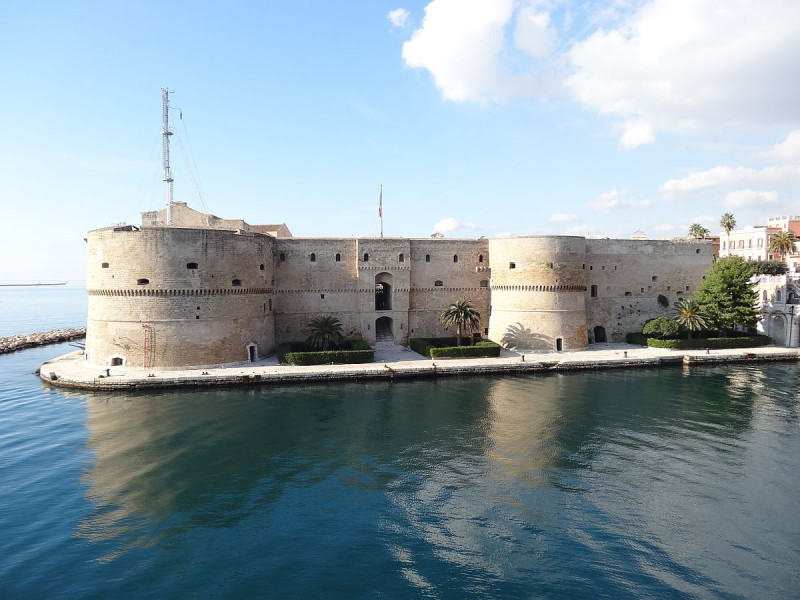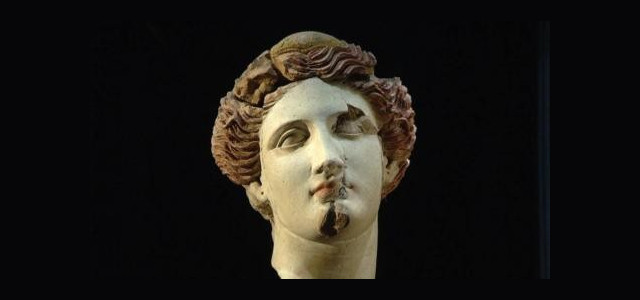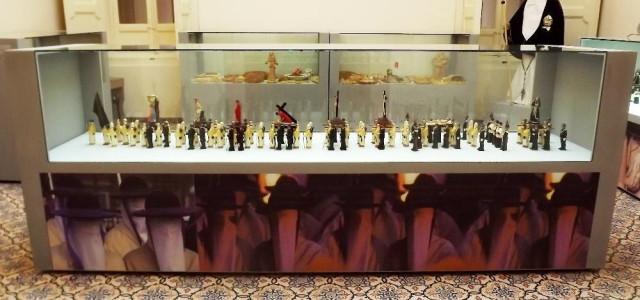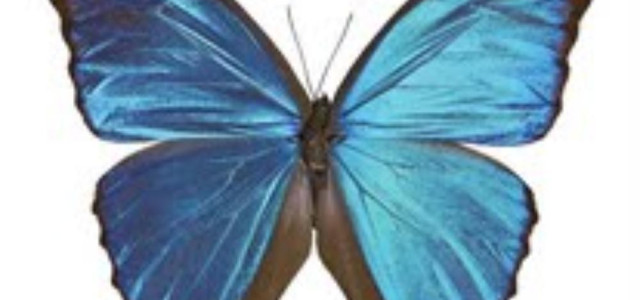Taranto
Not to be confused with Toronto, the largest city in Canada. For other uses, see Tarentum (disambiguation). Taranto (Italian pronunciation: [ˈtaːranto] ( ); Latin: Tarentum; Ancient Greek: Τάρᾱς Tarās; Modern Greek: Τάραντας, Τάραντα Tarantas, Taranta; Tarantino "Tarde") is a coastal city in Apulia, Southern Italy. It is the capital of the Province of Taranto and is an important commercial port as well as the main Italian naval base. It is the third-largest continental city of Southern Italy: according to 2011 population census, it has a population of 200,154. Taranto is an important commercial and military port. It has well-developed steel and iron foundries, oil refineries, chemical works, some shipyards for building warships, and food-processing factories. Taranto is known as "The Spartan City" because it was founded by the Spartans in 706 BC. In ancient times around 500 BC the city was one of the largest in Italy with population estimates up to 300,000 people. Other estimates are lower; the built-up area was 530 hectares (1300 acres). Overview Taranto's pre-history dates back to 706 BC when it was founded as a Greek colony, established by the Spartans. The ancient city was situated on a peninsula; the modern city has been built over the ancient Greek city of which only a few ruins remain, including part of the city wall, two temple columns dating to the 6th century BC, and tombs. The islets of S. Pietro and S. Paolo (St. Peter and St. Paul), collectively known as Cheradi Islands, protect the bay, called Mar Grande (Big Sea), where the commercial port is located. Another bay, called Mar Piccolo (Little Sea), is formed by the peninsula of the old city, and has flourishing fishing. Mar Piccolo is a military port with strategic importance. At the end of the 19th century, a channel was excavated to allow military ships to enter the Mar Piccolo harbour, and the ancient Greek city become an island connected to the mainland by bridges. In addition, the islets and the coast are strongly fortified. Because of the presence of these two bays, Taranto is also called “the city of the two seas”. The Greek colonists from Sparta called the city Taras (Τάρας), after the mythical hero Taras, while the Romans, who connected the city to Rome with an extension of the Appian way, called it Tarentum. The natural harbor at Taranto made it a logical home port for the Italian naval fleet before and during the First World War. During World War II, Taranto became famous as a consequence of the November 1940 British air attack on the Regia Marina naval base stationed here, which today is called the Battle of Taranto. Taranto is also the origin of the common name of the Tarantula spider family, Theraphosidae, even though strictly speaking there are no members of Theraphosidae in the area. In ancient times, residents of the town of Taranto, upon being bitten by the large local Wolf Spider, Lycosa tarentula, would promptly do a long vigorous dance like a Jig. This was done in order to sweat the venom out of their pores, even though the spider's venom was not fatal to humans. The frenetic dance became known as the Tarantella. Physical geography Taranto faces the Ionian Sea. It is 14.5 metres (48 ft) above sea level. It was built on a plain running north/north-west–southeast, and surrounded by the Murgia plateau from the north-west to the east. Its territory extends for 209.64 square kilometres (80.94 sq mi) and is mostly underwater. It is characterised by three natural peninsulas and a man-made island, formed by digging a ditch during the construction of Aragon Castle. The city is known as the "city of two seas" because it is washed by the Great Sea in the bay between Punta Rondinella to the northwest and Capo San Dante to the south, and by the vast reservoir of the Little Sea. Great Sea and Little Sea The Great Sea is frequently known as the Great Sea bay as that is where ships harbour. It is separated from the Little Sea by a cape which closes the gulf, leading to the artificial island. This island formed the heart of the original city and it is connected to the mainland by the Ponte di Porta Napoli and the Ponte Girevole. The Great Sea is separated from the Ionian Sea by the Capo San Vito, the Isole Cheradi of St Peter and St Paul, and the three islands of San Nicolicchio, which are completely incorporated by the steel plant. The latter form a little archipelago which closes off the arc creating the natural Great Sea bay. The Little Sea is considered to be a lagoon so it presents problems of water exchange. It is virtually divided into two by the Ponte Punta Penna Pizzone, which joins the Punta Penna to the Punta Pizzone. The first of these forms a rough triangle, whose corners are the opening to the east and the Porta Napoli channel linking it to the Great Sea in the west. The second half forms an ellipse whose major axis measures almost 5 kilometres (3 miles) from the south-west to the north-east. The Galeso river flows into the first half. The two seas have slightly different winds and tides and their underwater springs have different salinities. These affect the currents on the surface and in the depths of the Great Sea and the two halves of the Little Sea. In the Great Sea and in the northern part of the Little Sea, there are some underwater springs called citri, which carry undrinkable freshwater together with salt water. This creates the ideal biological conditions for cultivating Mediterranean mussels, known locally as cozze. Climate The climate of the city, recorded by the weather station situated near the Grottaglie Military Airport, is typical of the Mediterranean with frequent Continental features. The spring is usually mild and rainy, but it is not uncommon to have sudden cold spells come in from the east, which often cause snowfall. The summer is very hot and humid, with temperatures reaching up to 40 °C (104 °F). On 28 November 2012 a large F3 tornado hit the port of Taranto and damaged the Taranto Steel Mill where workers were protesting against the plant's pollution emissions; about 20 people were injured, and another man was reported missing. The tornado is one of nine to hit Italy since 1 October. It is classified as Geographical zone C and having a degree-day of 30. History Taranto was founded in 706 BC by Dorian Greek immigrants as the only Spartan colony, and its origin is peculiar: the founders were Partheniae ("sons of virgins"), sons of unmarried Spartan women and Perioeci (free men, but not citizens of Sparta); these out-of-wedlock unions were permitted extraordinarily by the Spartans to increase the prospective number of soldiers (only the citizens of Sparta could become soldiers) during the bloody Messenian wars, but later they were retroactively nullified, and the sons were then obliged to leave Greece forever. Phalanthus, the Parthenian leader, went to Delphi to consult the oracle: the puzzling answer designated the harbour of Taranto as the new home of the exiles. The Partheniae arrived in Apulia, and founded the city, naming it Taras after the son of the Greek sea god, Poseidon, and of a local nymph, Satyrion. According to other sources, Heracles founded the city. Another tradition indicates Taras as the founder of the city; the symbol of the Greek city (as well as of the modern city) depicts the legend of Taras being saved from a shipwreck by riding a dolphin that was sent to him by Poseidon. Taranto increased its power, becoming a commercial power and a sovereign city of Magna Graecia, ruling over the Greek colonies in southern Italy. Its independence and power came to an end as the Romans expanded throughout Italy. Taranto won the first of two wars against Rome for the control of Southern Italy: it was helped by Pyrrhus, king of Greek Epirus, who surprised Rome with the use of elephants in battle, a thing never seen before by the Romans. Rome won the second war in 272 B.C. This subsequently cut off Taranto from the centre of Mediterranean trade, by connecting the Via Appia directly to the port of Brundisium (Brindisi). Ancient art Like many Greek city states, Taras issued its own coins in the 5th and 4th centuries B.C. The denomination was a Nomos, a die-cast silver coin whose weight, size and purity were controlled by the state. The highly artistic coins presented the symbol of the city, Taras being saved by a dolphin, with the reverse side showing the likeness of a hippocamp, a horse-fish amalgam which is depicted in mythology as the beast that drew Poseidon's chariot. Taras was also the center of a thriving decorated Greek pottery industry during the 4th century BC. Most of the South Italian Greek vessels known as Basilican ware were made in different workshops in the city. Unfortunately, none of the names of the artists have survived, so modern scholars have been obliged to give the recognizable artistic hands and workshops nicknames based on the subject matter of their works, museums which possess the works, or individuals who have distinguished the works from others. Some of the most famous of the Apulian vase painters at Taras are now called: the Iliupersis Painter, the Lycurgus Painter, the Gioia del Colle Painter, the Darius Painter, the Underworld Painter, and the White Sakkos Painter, among others. The wares produced by these workshops were usually large elaborate vessels intended for mortuary use. The forms produced included volute kraters, loutrophoroi, paterai, oinochoai, lekythoi, fish plates, etc. The decoration of these vessels was red figure (with figures reserved in red clay fabric, while the background was covered in a black gloss), with overpainting (sovradipinto) in white, pink, yellow, and maroon slips. Often the style of the drawings is florid and frilly, as was already the fashion in fourth-century Athens. Distinctive South Italian features also begin to appear. Many figures are shown seated on rocks. Floral motifs become very ornate, including spiraling vines and leaves, roses, lilies, poppies, sprays of laurel, acanthus leaves, etc. Often the subject matter consists of naiskos scenes (scenes showing the statue of a deceased person in a naos, a miniature temple or shrine). Most often the naiskos scene occupies one side of the vase, while a mythological scene occupies the other. Images depicting many of the Greek myths are only known from South Italian vases, since Athenian ones seem to have had more limited repertoires of depiction. Municipal bankruptcy The Municipality of Taranto was declared bankrupt because - as ascertained by Francesco Boccia, chief of the liquidation committee - as of 31 December 2005, it had accrued liabilities in an amount equal to 637 million euros. This is one of the biggest financial crises which has ever hit a municipality. The fact that the municipality went bankrupt was officially declared on 18 October 2006 by the receiver Tommaso Blonda, appointed further to the resignation of the mayor, Rossana Di Bello, following her one-year-and-four-months imprisonment after her conviction for abuse of office and documental forgery in relation to investigations made on the contract for the management of the city incinerator given to the company Termomeccanica. Transport Taranto railway station connects the city with Rome, Naples, Milan, Bologna, Bari, Reggio di Calabria and Brindisi. Environment In 1991 Taranto was declared a high environmental risk area by the Ministry of Environment. As a consequence of the pollutants discharged into the air by the factories in the area, most notably the ILVA steel plant, part of Gruppo Riva, Taranto is the most polluted city in Italy and western Europe. 7% of Taranto's pollution is produced by the public; 93% is produced by factories. In 2005, the European Pollutant Emission Register estimated dioxin emissions from the Taranto ILVA plant were responsible for 83% of Italy's total reported emissions. Every year the city is exposed to 2.7 tonnes (2.7 long tons; 3.0 short tons) of carbon monoxide and 57.7 tonnes (56.8 long tons; 63.6 short tons) of carbon dioxide. In 2014, the Italian National Institute of Emissions and their Eources, state that Taranto stands third in the world behind China's Linfen, and Copşa Mică in Romania, the most polluted cities in the world due to factories' emissions. In particular, the city produces minety-two percent of Italy's dioxin. This is 8.8 percent of the dioxin in Europe. Between 1995 and 2004, leukaemias, myelomas and lymphomas increased by 30 to 40 percent. Dioxin accumulates over the years. Over 9 kilos of dioxin have been discharged into the city's air by its factories. Grazing is banned within 20 kilometres (12 mi) of the ILVA plant. In 2013, the Riva family, owner of the ILVA plant, is being tried for ecological disaster. Emissions of both carbon monoxide, carbon dioxide and dioxin have decreased. Animal species have returned that had left, including as swallows, cranes, dolphins, seahorses and the coral reef. Architecture and landmarks Taranto has a number of sites of historic value. Sitting along the Little Sea, The Aragonese Castle was built in the 15th century with the intention to protect the town from the Turks' frequent raids. The castle replaced a pre-existing fort which was deemed unfit for 15th century warfare. The old town, including Piazza Fontana, the church of San Domenico, the Madonna della Salute Sanctuary, and a number of old palazzi, is standing exactly as it did a thousand years ago, when the Byzantines rebuilt what the Saracens had razed to the ground in 927 AD. The picturesque alleyways, arches and stairwells, along with the old crafts workshops, contribute to its unique atmosphere. Taranto features several Greek temple ruins - some stretching as far back as the 6th century BC - such as the remains of a Doric Temple still visible on Piazza Castello. A number of 18th-century palazzi adorn the town centre. For years, they served as the main residence of local aristocratic families and these include Palazzo Carducci-Artenisio (1650), Palazzo Galeota (1728) and Palazzo Latagliata. The Ponte Girevole (swing bridge), built in 1887, runs across the navigable ship canal that joins Mar Piccolo (Little Sea) with Mar Grande (Big Sea) and stretches along 89.9 metres (295 ft). When the bridge is open, the two ends of the city are literally left without connection. An important institution of Taranto is the "Galileo Ferraris" high school, founded in 1848, located in via Mascherpa 10. This school is famous for its highly developed level of instruction, due to the high quality of its teachers and students. Others schools are: IIS Archita, IIS Quinto Ennio (in Literature), IIS Aristosseno (Languages), and ITIS Pacinotti (in IT) and ITC V. Bachelet (in Commercial and Accounting - famous for the activities at BIT MILANO). The Promenade (lungomare), named after former Italian king Victor Emmanuel III, overlooks the Mar Grande, with the imposing views of its natural harbour and commercial port. Society Demographic evolution Census populations Dialect The city is the centre of the Tarantino dialect (Dialètte tarandine) of the Sicilian language. As a result of the city's history, it is influenced by Greek, Vulgar Latin and French. International relations Taranto is twinned with: Sparta, Greece. Brest, France; since 1964. Donetsk, Ukraine; a sister city since 1985. Alicante, Spain; since 2010. Islamabad, Pakistan; since 2010. Notable people These historical figures have had a relationship with the city. Not all of them were actually born in Taranto. Archytas of Tarentum, philosopher, mathematician, astronomer, statesman, strategist and commander-in-chief of the army of Taranto Philolaus, mathematician and philosopher Aristoxenus, peripatetic philosopher, and writer on music and rhythm Leonidas of Tarentum, poet Lysis of Tarentum, philosopher Cleinias of Tarentum, Pythagorean philosopher Rhinthon (c. 323–285 BC), dramatist Livius Andronicus, poet Titus Quinctius Flamininus, propraetor of Tarentum Pacuvius, tragic poet, died in Tarentum in 130 BC Cataldus, archbishop and patron saint of Taranto Bohemond of Taranto, (born in Calabria) key military leader on the First Crusade Gil Albornoz, archbishop of Taranto in 1644 Giovanni Paisiello, composer Pierre Choderlos de Laclos, Napoleonic army general and novelist, died in Taranto Etienne-Jacques-Joseph-Alexandre MacDonald (1765–1840), duke of Taranto and marshal of France Marcus Fulvius Nobilior, rumoured to have been born here and not Rome as was first assumed Riccardo Tisci, fashion designer, creative director of Givenchy Roberta Vinci, professional tennis player Cosimo Damiano Lanza, pianist, harpsichordist and composer Pino De Vittorio, singer, actor Quentin Tarantino, whose family derives its surname from its origins in the city Michele Riondino, actor, director, singer Laura Albanese, Italian-Canadian newscaster and politician Nicola Martinucci, cantante lirico - tenore See also Taranto F.C. 1927 Tarantella References Notes External links Official website Taranto Jewish History Culture Centre Filonide Tourism in Taranto Holy Week Rites in Taranto, Italy (website in English and Spanish) MARTA: Museo nazionale ARcheologico TAranto (Taranto Archaeological National Museum) Word of the Day: Tarantula and Tarantella, From Taranto, etymology and folklore





